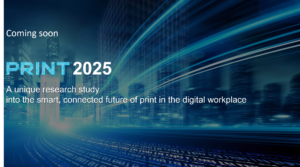
HP sets out ambitious sustainability targets
June 22, 2019
Articles, Channel, Managed Print Services, Trends
HP Inc has released its 2018 Sustainable Impact Report, including an industry-leading goal to increase recycled content plastics across its print and personal systems portfolio to 30% by 2025. According to the report, HP’s Sustainable Impact programs drove more than $972 million dollars of new revenue for HP in 2018, a 35% year-over-year increase. As a market leader, HP has an opportunity not only to drive competitive advantage through its ambitious sustainability targets, but also drive change and deeper commitment to supporting the circular economy across the print industry.
Applying circular economy principles to the print industry
Rapid population growth along with increasingly scarce natural resources means that the traditional linear “take, make, dispose” production model is no longer viable. This requires a shift towards a more circular and low-carbon model, which requires sustainable and operational excellence in how products are designed, delivered, recovered, repaired and reused.
The circular economy is a regenerative approach that strives to maintain products, components and materials at their highest utility and value for as long as possible, minimising waste. As such it brings together emerging practices such as subscription-based models and traditional concepts such as materials recycling, reuse and reduction. The print industry has long been striving to enhance its sustainability credentials, with circular economy practices already well established. This includes the manufacturing process, the responsible recycling of ink and toner, and the provision of hardware, software and services, which eliminate wasteful paper and energy usage.
Through a circular supply chain, products are designed and optimised for a cycle of disassembly and reuse, providing opportunities for remanufacturing and refurbishment. Products are increasingly built for longevity and energy efficiency, with fewer moving parts that can fail and fewer consumables that add to waste and need to be replaced. Innovation in inkjet print technology, for instance, is designed to reduce environmental impact. This is enabled through higher capacity ink models plus lower CO2 emissions and power consumption in comparison to laser print technology.
With today’s printers now operating as smart connected devices, new service innovation capabilities which harness predictive analytics enable manufacturers to extend product life through proactive repairs, software upgrades and firmware updates. Fleet management software also enables businesses to route jobs to the most efficient devices and keep tighter control over energy consumption.
When it comes to recycling and recovery, many print manufacturers operate take-back programmes, giving consumers and businesses the facility to return and responsibly recycle hardware and consumables at the end of the device’s life.
The shift from product to service-based models is already well underway. Meanwhile, manufacturers have already developed innovative models to move away from selling printers as physical products to selling printing as a service. Through a usage model, managed print services (MPS) offers businesses predictable expenses and eliminates capital expenditure whilst reducing operational expenses. In this way, manufacturers retain ownership of their products, and sell services enabling the optimal use of resources.
HP’s bold sustainability ambitions
HP’s full circle approach comprises a commitment to decoupling growth from consumption, pledging to make printing with HP forest positive, carbon neutral, and part of a circular economy.
This includes:
Forest Positive
- HP committed that all HP brand paper and paper-based product packaging will be derived from certified and recycled sources by 2020, with a preference for virgin fibre from certified sources of the Forest Stewardship Council (FSC).
- Certified HP Indigo Digital Print for compostable packaging
- Launched partnership with ELLE Magazine to deliver the world’s first sustainably printed fashion magazine
- Established goal for all HP consumer printing business to be forest positive by 2021
Carbon Neutral
HP’s commitment to reduced energy consumption and emissions with more energy efficient products:
- Achieved a 33% annual reduction in carbon emissions, energy consumption with HP’s Managed Print Services
- Laid the groundwork for a carbon credits pilot program, established goal for HP Instant Ink & Managed Print Services to be carbon neutral by 2025
Circular Economy
HP has already a long-established closed loop recycling process for its ink and toner cartridges through the HP Planet Partners program, available in 74 countries. Since 2000, HP has used more than 199 million pounds of recycled plastic to manufacture 4.2 billion HP Original ink and toner cartridges. HP’s target is for the HP Print Portfolio to incorporate 30% recycled plastic content by 2025. To date its progress includes:
- Millions of subscribers for instant ink cartridges, made with recycled ocean-bound plastics
- Delivered printers made with up to 30% closed-loop, post-consumer plastics and committed to achieving 30% recycled content plastic across our print portfolio by 2025. Introduced world’s first Toner Tank in emerging markets, made with more than 25% recycled plastic while the toner reload kit is made of 75% recycled plastic
Leading the march on sustainability – and profitability
In a rapidly commoditised market, and as consumer, employee and investor expectations on corporate responsibility grow, a strong commitment to sustainability strategies can foster company longevity. HP is strongly positioned as a market leader to advance sustainability commitments across the print industry. The company has a firm eye on the commercial benefits, too, being upfront about the revenue and deals it attributes to its sustainability strategy. HP is not the first in the industry to make the link between sustainability and profitability, but here they are spelling it out in unambiguous terms. This analysis will no doubt spur on industry rivals who may well feel the pressure to more thoroughly analyse and articulate their own performance.




